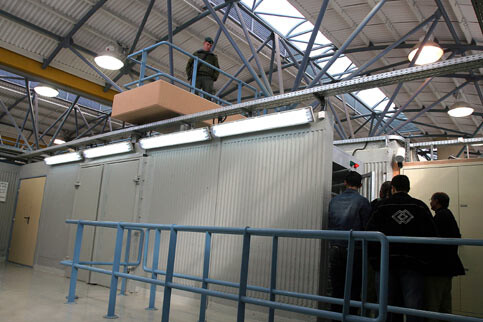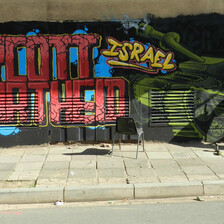
A very expensive “temporary security measure”: The new checkpoint between Bethlehem and Jerusalem (MaanNews/Inbal Rose)
Today is my mother’s birthday. She called my cellphone as my dear friend Areej and I were walking in the late afternoon shadow of the brand-new Apartheid Wall and “terminal” seperating Bethlehem from the rest of the goddamn world. To prove that i was there, i held the phone up to the wall and slapped it as hard as i could.
The “terminal,” as it is being called, is a cattle-catch maze of turnstyles and x-ray machines, all enclosed in an enormous building of wire and steel and sniper weapons with crosshairs tuned like a fiddle. This is on the “Jerusalem” side of the wall, which one is able to access only after papers are shuffled, cars are inspected, and people are humiliated and intimidated, or perhaps beaten and arrested and tortured. There is a sign on the slick asphalt that reads “Welcome to Jerusalem” in English, Arabic and Hebrew; I suspect that in the coming weeks or months, it will eventually read “Welcome to Israel.” This is how the system operates. People know the drill. In the West Bank, a trailer with a few rabid settlers becomes an “outpost,” which becomes a “settlement,” which becomes a “neighborhood.”
Here is the slow, constant dissapearing of a people. Like a low-power vaccuum, like a lake draining from a tiny breach, the air here is thick with the vibrating hum of genocide.
Here is the Apartheid Wall, in its 30-foot high glory, paid for by you and me. It slices, it dices. It snakes, it breaks. There is a good amount of artwork; graffiti and murals and painful comments. My favorite anarchist-graf artist Banksy has a plethora of pieces here, splashed across the sweeping concrete canvas. In the street, at the checkpoint, there is silence everywhere. No one talks, but the artwork shouts and spits and kicks for them.
Last year, there was just the military checkpoint, consisting of an ugly green shack and snarly, vicious Israeli soldiers. The apartheid wall was being built clean across the road into Bethlehem, the historical straight shot from Jerusalem city (a ten minute drive), but one could still walk across (that is, those who have a permit or those with international passports — my friend Areej hasn’t been to Jerusalem in six years). Now it’s just the wall and a sniper tower and a monstrous gate. Shops on the street, once bustling, are closed and abandoned. What remains, of course, is the silent sucking sound of a disappearing people.
Here is the Apartheid Wall. But look closely — there are cracks in places; almost as if the rocks ground up into its cement are slowly, carefully, quietly breaking out.
Related links
Nora Barrows-Friedman, 27, is the Senior Producer and co-host of
Flashpoints on Pacifica Radio. This is her third time reporting from occupied Palestine. Currently, she is volunteering at the Ibdaa Cultural Center in Dheisheh refugee camp, teaching youth in a media training course.





